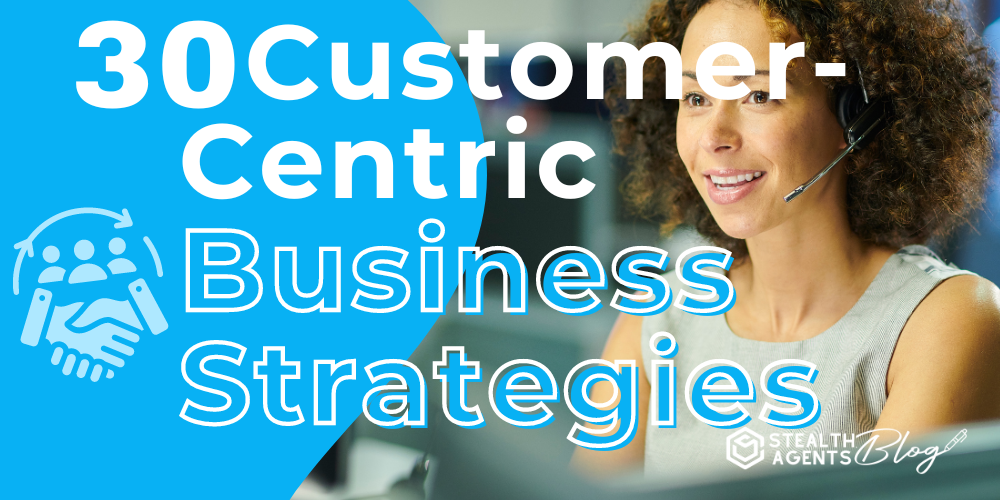Customer-centric business strategies have emerged as a crucial aspect of modern commerce by honing in on customer-centered strategies.
Remarkably, 86% of buyers are willing to pay more for superior customer experiences, highlighting the essential nature of a customer-centric business strategy and customer-centric ideas. By implementing customer-centric strategies and customer-centric trade solutions, companies boost satisfaction and cultivate enduring relationships.
Transitioning to a customer-focused model can enhance profitability by up to 60%, proving its strategic importance alongside scalability strategies in business. As competition intensifies, embedding customer-centric business strategies, social media strategies business, and employee retention strategies becomes vital for growth.
To seamlessly integrate these methods, Stealth Agents offers free consultations on client preferences, virtual assistant services, and virtual assistant pricing, making them a key ally in your customer-centric journey.
What is Customer-Centric?
Customer-centricity refers to a business approach prioritizing customers’ needs and preferences in every aspect of operations. It involves developing customer-centered strategies that ensure products and services meet or exceed customer expectations.
A customer-centric business strategy focuses on creating customer value, which drives loyalty and long-term success.
Implementing customer-centric strategies may involve crafting customer-centric trade solutions and adopting innovative customer-centric ideas that align with customer demands. Businesses that embrace customer-centric business strategies are better equipped to adapt their business decision-making strategies to evolving market trends.
This approach enhances customer satisfaction and helps businesses demonstrate professionalism in their interactions and offerings.
Adopting a customer-centric mindset positions companies to thrive in competitive markets by fostering genuine connections with their clientele.
Why is Customer-Centric Important?
To improve customer happiness, loyalty, and retention, businesses must prioritize customers.
Implementing customer-centric business strategies significantly enhances the brand image by addressing client demands. This approach satisfies customers and encourages them to share their positive experiences on social media and through word-of-mouth, further boosting brand reputation and customer loyalty.
Meeting clients’ requirements, wants, and preferences raises the chance of a pleasant product or service experience. Increased customer satisfaction can lead to loyalty and corporate preference over competitors.
Implementing customer-centric business strategies can generate free publicity and attract new clients through positive reviews. However, unsatisfied customers may leave negative feedback, damaging the brand’s reputation. Balancing these outcomes is crucial for maintaining a solid market presence.
How Do You Become More Customer-Centric?
To enhance customer happiness, loyalty, and retention, businesses must implement customer-centric business strategies that meet clients’ requirements, desires, and preferences, increasing the likelihood of a positive product or service experience.
Customer satisfaction boosts brand loyalty and elevates the brand’s preference over competitors.
By prioritizing client demands, businesses can significantly enhance their brand image. Satisfied clients are more inclined to share their positive experiences on social media or through word-of-mouth, providing the business with valuable, cost-free promotion.
However, dissatisfied clients can quickly leave negative reviews, potentially harming the business’s reputation.
Companies can mitigate such risks by effectively utilizing customer-centric business strategies and fostering a loyal customer base. Ultimately, these strategies are essential for turning customer satisfaction into a robust growth and acquisition tool.
Effective Customer-Centric Business Strategies
Many ideas for customer engagement strategies and determining businesses’ intended audience needs and goals. But might this list be informative and helpful to your company?
1. Implementing a Customer Relationship Management (CRM) System
Carefully track Customer Interactions and Preferences using a CRM System to personalize services. This approach enables businesses to streamline operations, improve customer satisfaction, and foster long-lasting relationships by delivering targeted and meaningful customer experiences across various touchpoints.
2. Personalizing Product Suggestions Using Client Data
Utilize Customer Data to suggest products tailored to individual preferences for a more engaging shopping experience. By analyzing purchase history and behavior patterns, businesses can offer relevant recommendations that increase conversion rates and enhance customer satisfaction and loyalty.
3. Creating a Loyalty Program for Repeat Customers
Create a strategy for a Loyalty Program to retain consumers, encourage Repeat Business, and build long-term relationships. Loyalty programs incentivize purchases, reward customer loyalty, and foster a sense of belonging, ultimately driving higher customer lifetime value and business growth.
4. Providing Exceptional Customer Service Through Various Channels
Ensure Excellent Customer Service through Phone, Email, and Live Chat to address inquiries promptly and enhance customer satisfaction. Multichannel support allows businesses to meet customers where they are, ensuring quick resolutions and positive experiences that bolster customer loyalty.
5. Building an Online Community for Customers
An Online Community where customers can connect, communicate, and interact with the business fosters a sense of belonging. This platform encourages customer engagement, feedback sharing, and brand advocacy, creating a vibrant ecosystem that amplifies customer loyalty and support.
6. Surveys and Feedback Forms for Customers
Gather customer feedback regularly to understand demands and areas for improvement, allowing for continuous enhancements. Collecting customer insights helps businesses adapt to changing needs, refine products and services, and maintain a competitive edge in the market.
7. Holding Focus Groups to Gain Insights on Customer Preferences
Conduct Focus Groups to gather in-depth insights into Customer Preferences, helping shape products and services accordingly. These sessions provide qualitative data that can inform strategic decisions, ensuring offerings align with customer desires and market trends and enhancing overall satisfaction.
8. Creating a Customer-Centric Culture Within the Organization
Instill a Customer-Centric Mindset across the organization, ensuring every team member prioritizes customer satisfaction. A company-wide focus on the customer fosters an environment where employees are motivated to deliver exceptional service, leading to improved business performance and customer loyalty.
9. Offering Flexible Return and Exchange Policies for Customers
Implement Customer-Friendly Return and Exchange Policies to build trust and provide a hassle-free shopping experience. Flexible policies enhance customer confidence, reduce purchase hesitations, and encourage repeat business, ultimately contributing to a strong brand reputation and customer retention.
10. Using Social Media to Interact with Customers
Connect with Consumers on Social Media to address concerns, build relationships, and showcase the brand’s human side. Active engagement on these platforms strengthens customer connections, provides real-time feedback, and expands brand reach and awareness through authentic interactions.
11. Providing Training and Resources for Employees
Prepare Workers with skills and resources to understand and serve customers effectively. Comprehensive training programs equip employees with the knowledge to address customer needs professionally, enhancing service quality and fostering a culture of continuous improvement within the organization.
12. Utilizing Data Analytics to Track Customer Behavior
Analyze Customer Behavior through Data Analytics to make informed decisions and tailor strategies to customer preferences. Leveraging data insights allows businesses to predict trends, personalize marketing efforts, and optimize operations, ultimately improving customer satisfaction and driving growth.
13. Conducting Market Research to Understand Customer Needs
Research the Market often to keep informed about evolving customer needs and trends. Staying attuned to market dynamics helps businesses anticipate changes, adapt offerings, and maintain relevance, ensuring they meet customer expectations and sustain competitive advantage.
14. Offering Personalized Discounts or Promotions
Tailor Discounts and Promotions based on individual customer preferences and purchase history. Personalized offers increase customer engagement, drive sales, and enhance loyalty by demonstrating a deep understanding of customer desires and rewarding them with meaningful incentives.
15. Hosting Exclusive Events for Loyal Customers
Show appreciation by organizing Special Events or promotions exclusively for loyal customers. These events foster a sense of exclusivity and strengthen customer relationships, encouraging continued patronage and word-of-mouth referrals that contribute to a loyal customer base.
16. Implementing a User-Friendly Website and Mobile App
Make purchasing easy with a User-Friendly Website and Mobile App that prioritizes ease of navigation. A seamless digital experience enhances customer satisfaction, reduces friction during transactions, and increases conversion rates by making it effortless to discover, browse, and purchase products.
17. Collaborating with Influencers or Brand Ambassadors
Partner with Influencers to expand reach and attract new customers who align with the brand. Influencers provide authentic endorsements, amplify brand messages, and engage diverse audiences, boosting brand credibility and driving customer acquisition through trusted recommendations.
18. Creating Engaging and Informative Content for Customers
Produce Engaging Content, such as blogs and videos, to inform and entertain customers while promoting the brand. High-quality content establishes brand authority, attracts potential customers, and nurtures existing relationships by providing valuable information and insights.
19. Utilizing Chatbots to Provide Quick Customer Support
Implement Chatbots for quick and efficient customer support, enhancing the overall service experience. Automated responses reduce wait times, offer 24/7 assistance, and streamline customer interactions, leading to higher satisfaction levels and improved operational efficiency.
20. Partnering with Other Businesses to Provide Additional Value
Partner with Companies or Brands to offer additional value and services to customers. Strategic partnerships expand service offerings, enhance customer experiences, and create synergies that benefit both parties, ultimately leading to increased customer satisfaction and loyalty.
21. Rewarding Customers for Referrals Through a Referral Program
Encourage Customer Referrals by implementing a program that rewards customers for recommending the brand to others. Referral programs leverage word-of-mouth marketing, increase brand visibility, and incentivize existing customers to advocate for the brand, driving new customer acquisition.
22. Providing Personalized Packaging and Shipping Options
Offering customized Packaging Options and efficient shipping choices enhances the unboxing experience. Personalized touches elevate brand perception, foster excitement, and ensure a memorable customer experience that encourages repeat purchases and positive reviews.
23. Offering Virtual or In-Person Consultations
Provide personalized recommendations through virtual or in-person consultations that cater to individual customer needs. Consultations allow for a deeper understanding of customer requirements, enabling tailored advice and solutions that enhance satisfaction and foster stronger customer relationships.
24. Incorporating Customer Feedback into Product Development
Actively involve customer feedback in product development processes to meet consumer expectations for items. Engaging customers in the creation of products ensures offerings are aligned with market needs, increases product success rates, and demonstrates a commitment to customer-centric innovation.
25. Providing Transparency and Open Communication
Maintain Transparency in company policies and practices, fostering trust and open communication with customers. Honest interactions build customer confidence, reduce misunderstandings, and enhance brand reputation, creating a foundation for lasting customer loyalty and engagement.
26. Implementing a Customer Feedback Loop
Establish a Continuous Feedback Loop to improve the customer experience based on evolving needs and expectations. Regular feedback collection and analysis facilitate proactive adjustments, ensuring offerings remain relevant and customers feel valued and heard.
27. Personalizing Email Marketing Campaigns
Tailor Email Marketing Campaigns based on customer behavior and preferences for more effective communication. Personalized emails increase engagement, drive conversions, and enhance customer relationships by delivering relevant content that resonates with individual interests and purchase patterns.
28. Creating a User-Friendly Online Product Catalog
Develop a Comprehensive and User-Friendly Online Product Catalog with detailed information to aid customers in making informed decisions. An intuitive catalog, with clear and concise product descriptions, simplifies product discovery, enhances the shopping experience, and increases purchase confidence.
29. Using Gamification to Engage and Reward Customers
Implement Gamification elements to engage and reward customers for loyalty, creating a fun and interactive experience. Gamified experiences increase customer participation, boost brand interaction, and encourage repeat business by offering enjoyable and rewarding activities.
30. Providing Convenient and Efficient Payment Options
Offer Diverse and Efficient Payment Options, including online and mobile methods, to enhance the convenience of the shopping process. Easy payment solutions reduce barriers to purchase, improve customer satisfaction, and streamline transactions, encouraging continued patronage and business growth.
Takeaways
Creating a thriving business today means placing your customers at the heart of every decision. By implementing customer-centric business strategies, companies can build stronger relationships and foster loyalty, leading to sustained success.
These customer-centric business strategies and customer-centered strategies are not just trends; they are essential practices that can transform ordinary interactions into extraordinary experiences.
As businesses navigate an ever-evolving marketplace, understanding and anticipating customer needs through customer-centric business strategy becomes paramount. This approach enhances customer satisfaction and drives innovation and growth through customer-centric trade solutions.
By focusing on personalized experiences and responsive service, businesses can distinguish themselves from competitors with effective customer-centric strategies.
Moreover, integrating customer-centric business strategies ensures that companies remain agile and adaptable, ready to meet the challenges of tomorrow with inventive customer-centric ideas.
Leverage the expertise of Stealth Agents’ virtual assistants to seamlessly implement these strategies and elevate your customer service to new heights.












